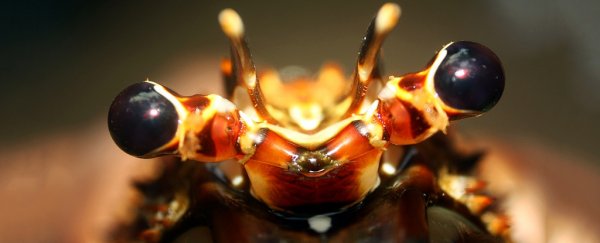Imagine a highly sophisticated body armor that is a tough as it is flexible, a shield that consists largely of water, but remains strong enough to prevent mechanical penetration.
Now imagine that this armor is not only strong, but also soft and stretchy, so much so that the wearer is able to move their body parts with ease, whether they're swimming in water, walking across the ground or rushing to escape danger.
That description might sound like a suit worn by a fictional hero in the DC Comics franchise, but it actually describes portions of a lobster's exoskeleton.
Researchers at the Massachusetts Institute of Technology and Harvard believe the soft membrane covering the animal's joints and abdomen - a material that is as tough as the industrial rubber used to make car tires and garden hoses - could guide the development of a new type of flexible body armor for humans, one designed to cover joints like knees and elbows.
The researchers' findings appeared in a recent edition of the journal Acta Materialia.
"We think this work could motivate flexible armor design," Ming Guo, the d'Arbeloff Career Development Assistant Professor in the mechanical engineering department at MIT, told MIT News, noting that lobsters' membrane has helped it survive on Earth for more than 100 million years.
If you could make armor out of these types of materials, you could freely move your joints, and it would make you feel more comfortable."
Ballistic vests - commonly referred to as "body armor" - are widely used by law enforcement officers and have been credited with saving thousands of officers from handgun and rifle ammunition, according to the National Institute of Justice. But the vests come with challenges as well.
As the Washington Post's Devlin Barrett reported in 2017, Kevlar - a tightly woven fiber panels designed to stop bullets from handguns - have expiration dates and usually last no more than five years.
Body armor can also be ill-fitting, particularly for female officers who sometimes require custom fitting, according to NIJ.
Some studies have shown that body armor can also impair the wearer's marksmanship and focus, as well as increasing "the physiological cost to complete a task when on duty," simultaneously providing protection and increased risk, according to the National Center for Biotechnology Information.
MIT researchers believe that lobsters could offer a solution to the problem plaguing most modern body armors: The more mobility an armor offers, the less it protects the wearer's body.
Guo told MIT News that the idea for developing body armor inspired by lobsters arrived while he was eating one and noticed that the transparent membrane on the animal's belly was difficult to chew. Unlike the crustacean's bone-like outer shell, the animal's softer tissues remained a mystery, he said.
Once researchers began to dissect those tissues, they made a surprising discovery. Making significant cuts into the membrane didn't affect the material's elasticity.
Researchers determined that the elasticity and strength is due to the membrane's unique structure, which includes tens of thousands of layers that they compare to plywood. The fibers within those layers help the material dissipate energy when it's under stress, making it "damage tolerant," researchers write.
"The knowledge learned from the soft membrane of natural lobsters sheds light on designing synthetic soft, yet strong and tough materials for reliable usage under extreme mechanical conditions, including a flexible armor that can provide full-body protection without sacrificing limb mobility," the study added.
Guo told MIT News that material designed to replicate the strength and flexibility of lobster membranes could also be used in soft robotics and tissue engineering.
2019 © The Washington Post
This article was originally published by The Washington Post.
